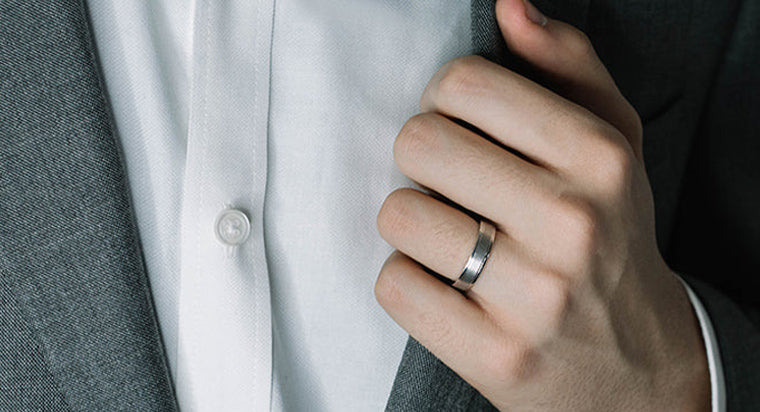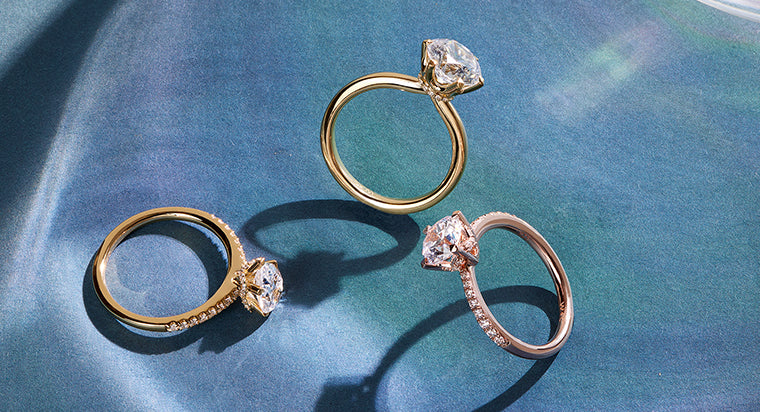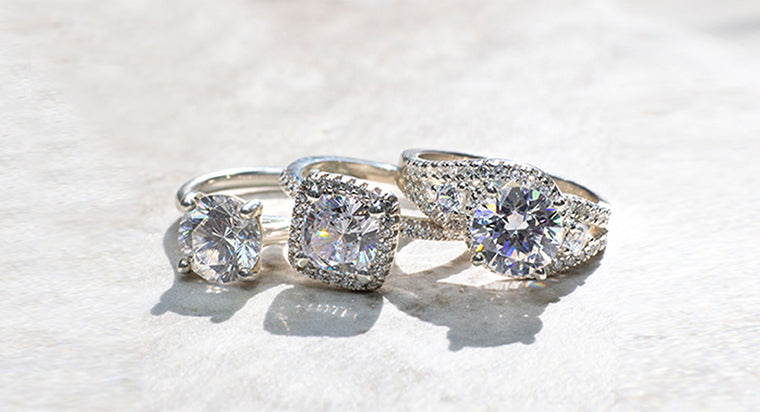Guide to Rhodium Plating

As you shop for jewelry and compare different metals, you’ve likely heard the term rhodium. In addition to providing a silvery-white reflective coating to white gold, it provides a durable layer that resists dents and scratches. In this post, we’ll discuss the ins and outs of rhodium plating.
TABLE OF CONTENTS
What is Rhodium Plating?
Rhodium is a rare, expensive metal that’s used to plate metals. It’s not used by itself in jewelry because even pure rhodium is brittle and not malleable. However, it does make an excellent plating material because it’s harder than gold. It offers a reflective, shiny, and protective coat that hides imperfections and protects jewelry from scratches. Another benefit is it doesn’t tarnish, corrode, or require specific cleaning procedures.
White gold is an alloy of gold and other metals, such as nickel, silver, or palladium. Pure gold is yellow in color, so although it’s mixed with these white metals, there’s still a tint of yellow. It appears more off-white rather than white without plating. Plating with rhodium gives white gold a brighter white color.
To plate a piece of jewelry, a jeweler layers rhodium plating of a specific thickness over the other metal. It has to be the right thickness to keep it from cracking, which is generally between .75-1.0 microns. A thinner layer allows the metal underneath to show, and a thicker layer would crack.
Rhodium plating is typically used on most white gold jewelry and also on some silver. Rhodium-plated silver makes it whiter, brighter, and most lustrous. Platinum provides a layer of durability, and this is especially useful for silver because it’s a softer metal. Pure silver is too soft to use in jewelry, so it contains other metals like copper, nickel, or a combination of the two. Copper in nickel in silver causes tarnishing, so rhodium prevents this from happening.
Rhodium and Skin Sensitivity
Another benefit of rhodium plating is that it’s nickel free, which makes it hypoallergenic. Some people have silver or nickel allergies, which affects their skin if the silver or white gold jewelry has nickel in the alloy. A thin layer of rhodium protects wearers with direct contact and allows them to wear silver and white gold.
In addition to being hypoallergenic, it also has the following benefits:
- Resistant to corrosion: Rhodium plating does not scratch, dent, or corrode.
- Highly reflective: Its shiny, white color is highly reflective and retains luster.
How Long Does Rhodium Plating Last?
While rhodium plating makes jewelry shinier and more durable, you might wonder how long it lasts. Generally, rhodium plating lasts a year or two depending on how often you wear it. It’s worn down by friction. So, if you have a wedding band that you wear every day, you might have to get it replated more often. Rings also wear faster than other pieces of plated jewelry. If you have a necklace that you only wear for special occasions, then the rhodium plating could last for years. Take a look at your piece of jewelry, and if you can see the base metal or it’s lost its luster, then it’s time to have your jewelry inspected and replated. It typically costs $50-100 to replate jewelry; more intricate pieces are on the higher end.
Caring for Rhodium Plated Jewelry
As mentioned, friction wears off the rhodium plating faster. So when you clean your jewelry, avoid rubbing it. Keep in mind that skincare products, sweat, chlorine, and cleaning products can diminish the luster of your plated jewelry. Here are some dos and don’ts:
Dos
- Use a little water if jewelry needs cleaning, but let it air dry.
- Take off jewelry when you’re headed to the gym, going for a run, or working in the yard to avoid unnecessary friction.
Don’ts
- Use water, soap and harsh chemicals, and skip rubbing it dry.
- Wear and and remove the jewelry constantly. Fidgeting with the jewelry, twisting rings, and playing with your necklace causes the rhodium plating to wear down faster.
Caring for Your Rhodium Plated Jewelry
- Avoid water, soap, and harsh chemicals. A little water won’t hurt, but let it air dry to avoid extra friction.
- Avoid taking rhodium plated jewelry on and off. Many people have a habit of twisting their necklaces or sliding rings up and down their fingers. Be careful not to fidget with your rhodium jewelry so that it lasts as long as possible.
- Try to reserve rhodium plated jewelry for special occasions to preserve it. Definitely don’t wear it in the yard or at the gym.
FAQs
Is rhodium plating durable?
Rhodium plating is durable and lasts a year or two, but rubs off over time with friction.
How often should rhodium plating be done?
Typically rhodium plating lasts a year or two depending on wear.
Does rhodium plating turn green with time?
No, rhodium plating does not turn green over time because it does not tarnish or corrode. If brass is rhodium plated and the plating wears off, the copper could turn your skin green.
Which is better: rhodium-plated silver or sterling silver?
Rhodium-plated jewelry adds an extra layer of protection to your items and displays a brighter white than sterling silver, white gold, or platinum. Rhodium plating also strengthens silver by adding a layer of protection from scratches and dings. The choice depends on the jewelry that you have and your preferences.
Is all white gold rhodium plated?









